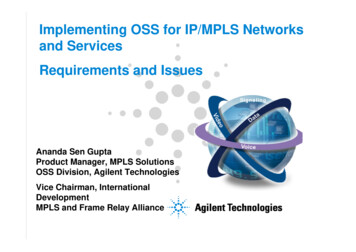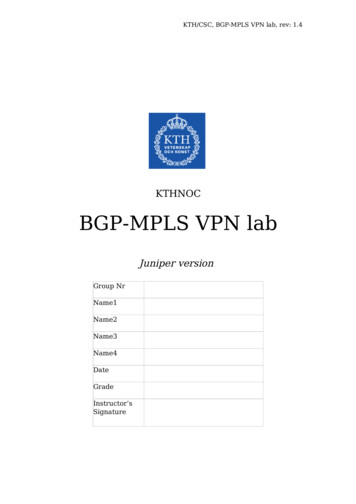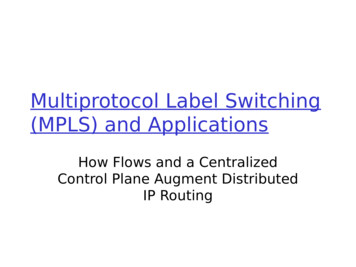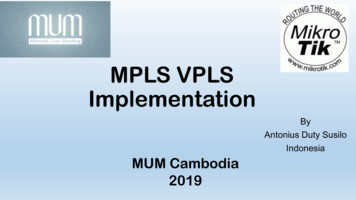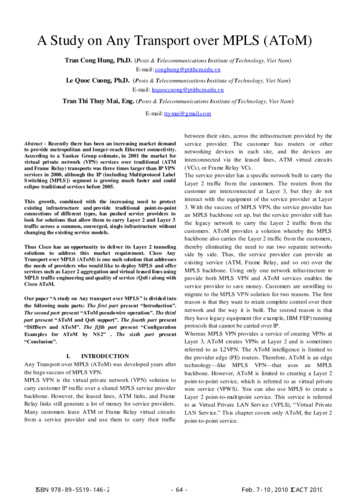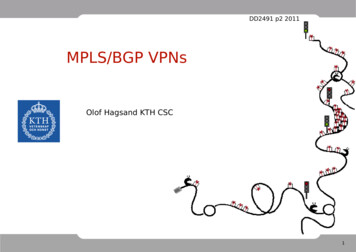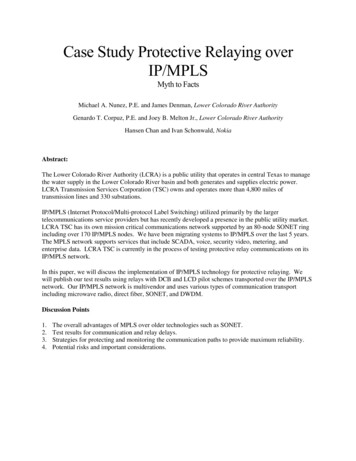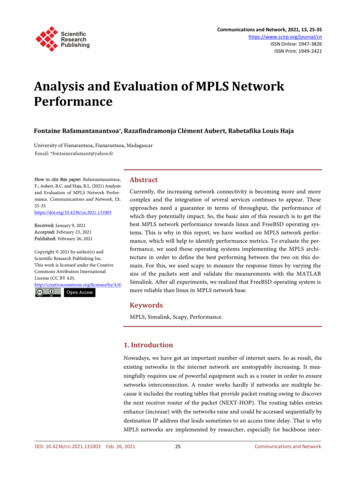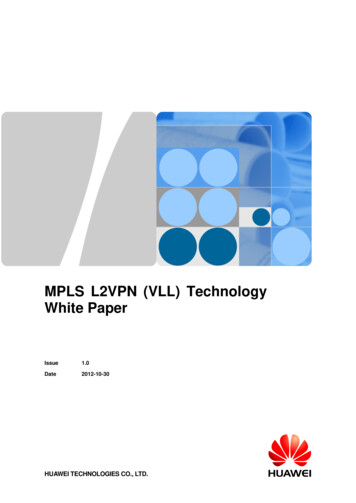
Transcription
MPLS L2VPN (VLL) TechnologyWhite PaperIssue1.0Date2012-10-30HUAWEI TECHNOLOGIES CO., LTD.
Copyright Huawei Technologies Co., Ltd. 2012. All rights reserved.No part of this document may be reproduced or transmitted in any form or by any means without priorwritten consent of Huawei Technologies Co., Ltd.Trademarks and Permissionsand other Huawei trademarks are trademarks of Huawei Technologies Co., Ltd.All other trademarks and trade names mentioned in this document are the property of their respectiveholders.NoticeThe purchased products, services and features are stipulated by the contract made between Huawei andthe customer. All or part of the products, services and features described in this document may not bewithin the purchase scope or the usage scope. Unless otherwise specified in the contract, all statements,information, and recommendations in this document are provided "AS IS" without warranties, guarantees orrepresentations of any kind, either express or implied.The information in this document is subject to change without notice. Every effort has been made in thepreparation of this document to ensure accuracy of the contents, but all statements, information, andrecommendations in this document do not constitute a warranty of any kind, express or implied.Huawei Technologies Co., Ltd.Address:Huawei Industrial BaseBantian, LonggangShenzhen 518129People's Republic of ChinaWebsite:http://enterprise.huawei.comIssue 1.0 (2012-10-30)Huawei Proprietary and ConfidentialCopyright Huawei Technologies Co., Ltd.i
MPLS L2VPN (VLL) Technology White PaperAbout This DocumentAbout This DocumentKeywords:MPLS VLLAbstract:Multi-Protocol Label Switching (MPLS) technologies make it easy to provide VPN servicesbased on IP technologies. MPLS VPNs are highly scalable and easy-to-manage. There are twoMPLS-based VPN services: L3 MPLS VPN and L2 MPLS VPN. MPLS L2VPN has twomodes: Virtual Private LAN Service (VPLS) and Virtual Leased Line (VLL). VLL applies topoint-to-point networking scenarios, while VPLS supports point-to-multipoint andmultipoint-to-multipoint networking. From users’ point of view, the whole MPLS network isa Layer 2 switched network, through which Layer 2 connections can be established betweensites. This document describes VLL.Acronyms:AcronymFull spellingMPLSMulti-Protocol Label SwitchingVLLVirtual Leased LineIssue 1.0 (2012-10-30)Huawei Proprietary and ConfidentialCopyright Huawei Technologies Co., Ltd.ii
MPLS L2VPN (VLL) Technology White PaperContentsContentsAbout This Document . ii1 Overview. 12 Basic Model . 32.1 MPLS L2VPN Model. 32.2 Advantages of the MPLS L2VPN . 43 Features . 53.1 Terminologies . 53.2 Frame Format . 53.3 Packet Forwarding Process . 64 Implementation of the MPLS L2VPN (VLL) . 74.1 CCC Mode . 74.2 Martini Mode . 84.3 Kompella Mode . 105 VLL Application . 11Issue 1.0 (2012-10-30)Huawei Proprietary and ConfidentialCopyright Huawei Technologies Co., Ltd.iii
MPLS L2VPN (VLL) Technology White Paper1 Overview1OverviewAs the world economy develops, increasing enterprises have to span greater distances toprovide quality services to an extensive clientele base. The employees of these enterprisesalso have to travel more frequently. As a result, enterprises seek out services that enable themto interconnect their branches, so that their employees can easily access enterprise networksfrom anywhere.Originally, service providers filled this need by providing leased lines, but leased lines havesignificant disadvantages. For example, leased lines are not applicable when there are a largenumber of branches or when the number of branches grows quickly. Furthermore, this methodis expensive and a network based on leased lines is difficult to manage.Then, Asynchronous Transfer Mode (ATM) and Frame Relay (FR) emerged, and serviceproviders turned to them to provide virtual circuits. With these new methods, enterprisescould establish their own Layer 3 networks for IP or IPX traffic based on the virtual circuits.However, the virtual links are point-to-point Layer 2 links, which make networks difficult toconfigure and maintain, especially when a new site is deployed.Later, after IP networks had become present almost everywhere in the world, serviceproviders began to focus on how to provide enterprises with low-cost private network servicesusing the existing IP networks.The Multi-protocol Label Switching (MPLS) VPN technology, which is easy to configure andallows service providers to change bandwidth settings easily, address this demand. Thistechnology uses a short but fixed-length label to encapsulate network layer packets, andintegrates IP's connectionless control and ATM's connection-oriented packet forwarding.Apart from IP routing and control protocols, MPLS also supports policy-based routing,meeting requirements of emerging applications. MPLS was initially developed to improveforwarding speeds of routers. Due to its intrinsic advantages, it is not limited to thisapplication. For example, MPLS has been widely applied to traffic engineering, VPN services,and other areas. As a result, it has gradually become an important standard for large-scale IPnetworks.Traditional VPN technologies use L2 tunneling protocols (such as L2TP, L2F and PPTP) orthe L3 tunneling technologies (IPSec and GRE). These technologies were quite successful andwidely applied. However, as the use of VPNs expanded, their drawbacks, such as itsexpansion and management limitations, have become more obvious. In addition, quality ofservice (QoS) and security are tough problems for the traditional VPN technologies.The MPLS technology can easily implement IP-based VPN services and satisfy therequirements for VPN expandability and manageability. MPLS VPNs allow forimplementation of value-added services. A single access point can be configured withIssue 1.0 (2012-10-30)Huawei Proprietary and ConfidentialCopyright Huawei Technologies Co., Ltd.1
MPLS L2VPN (VLL) Technology White Paper1 Overviewmultiple VPNs, each representing a different service, so that the network can transmitdifferent servicesThere are two types of MPLS-based VPN services: MPLS L3VPN and MPLS L2VPN. TheL2 MPLS VPN service comprises VPLS and VLL, where VLL applies to point-to-pointnetworking and VPLS applies to point-to-point and multipoint-to-multipoint VPN scenarios.From the user’s point of view, the entire MPLS network is an L2 switching network throughwhich L2 connections can be set up between different sites.This document focuses on the L2 MPLS VPN in VLL mode.Issue 1.0 (2012-10-30)Huawei Proprietary and ConfidentialCopyright Huawei Technologies Co., Ltd.2
MPLS L2VPN (VLL) Technology White Paper2 Basic Model2Basic Model2.1 MPLS L2VPN ModelFigure 2-1 MPLS L2VPN modelThe service provider has four provider edges (PEs) to provide VPN services for twocustomers. VPN2 has two sites located in different places, while VPN1 consists of three siteslocated in different places. As shown in Figure 2-1, the basic L2 MPLS VPN modelcomprises three major components: customer edge (CE), PE, and provider (P). The carriermanages the PEs, and customers manage the CEs.Issue 1.0 (2012-10-30)Huawei Proprietary and ConfidentialCopyright Huawei Technologies Co., Ltd.3
MPLS L2VPN (VLL) Technology White Paper2 Basic Model2.2 Advantages of the MPLS L2VPN Higher expandabilityMPLS VPN is much easier to expand than the traditional ATM or FR network. MPLSVPNs can multiplex multiple virtual circuits in the same LSP. A PE only maintainsinformation about one LSP for the virtual circuits; therefore, the system capacity is easyto expand. Clear management responsibilityThe MPLS L2VPN carrier only provides L2 connectivity, whereas L3 connectivity isprovided by customers. Therefore, route flapping caused by incorrect configuration on auser network does not affect stability of the carrier’s network. Higher security and confidentialityMPLS VPN can provide security and confidentiality equivalent to that of the ATM or FRVPN network. Since users maintain their own routing information, the carrier does notneed to worry about address overlapping among the users or whether the routinginformation of a user will be disclosed to private networks of other users. This alleviatesthe management load of the carrier while enhancing security of user information. Support for multiple network protocolsAs the carrier only provides L2 connectivity, customers can use any L3 protocol, such asIP, IPv6, IPX and SNA. Smooth upgrade from traditional L2VPNMPLS L2VPN is transparent to users. When the carrier upgrades the traditional L2VPNnetworks, such as ATM and FR networks, to the MPLS L2VPN networks, the customersdo not need to make any configuration. The upgrade has almost no impact on thecustomers except that data may be lost for a short time during the transition.Issue 1.0 (2012-10-30)Huawei Proprietary and ConfidentialCopyright Huawei Technologies Co., Ltd.4
MPLS L2VPN (VLL) Technology White Paper3 Features3Features3.1 Terminologies Virtual Leased Line (VLL): A point-to-point L2VPN service provided on the MPLSnetwork. Virtual Private LAN Service (VPLS): A point-to-multipoint andmultipoint-to-multipoint L2 VPN service provided on the MPLS network. Custom Edge (CE): User edge device directly connected to the service provider. The CEcan be a router or a switch. It cannot detect VPNs by itself. Provider Edge (PE): Carrier device directly connected to the CE. All the processing onthe VPN is conducted on the PE of the MPLS network. The PE must support MPLSVPN. Provider (P): Backbone device on the carrier’s MPLS network. The P is not directlyconnected to the CE. The P must support MPLS. Penultimate Hop Popping (PHP): To pop up a layer of label to simplify label search inMPLS and IP switching. Circuit Cross Connect (CCC): An L2 MPLS VPN implementation mode. Label Switched Path (LSP): A data forwarding path established through signaling orstatic configuration on the MPLS network. Label Distribution Protocol (LDP): One of the core protocols of MPLS. It classifiespackets, attaches labels to different types of packets, and establishes the label switchingpath.3.2 Frame FormatFigure 3-1 shows the VLL frame format.Figure 3-1 VLL frame formatL2 head Issue 1.0 (2012-10-30)Tunnel labelVC labelL2 PDUTunnel label (outer label): An MPLS label that forwards packets from a PE to anotherPE.Huawei Proprietary and ConfidentialCopyright Huawei Technologies Co., Ltd.5
MPLS L2VPN (VLL) Technology White Paper3 Features VC label (inner label): A label that identifies the PE-CE link. In CCC mode, the L2MPLS VPN does not have such a label. MPLS L2VPN supports the following link layer encapsulation modes: Ethernet andVLAN. Nodes in the same VPN must use the same encapsulation mode.3.3 Packet Forwarding ProcessMPLS L2VPN uses a label stack to transparently transmit user packets on an MPLS network.Tunnels are established between PEs through static configuration or signaling protocols. A PEadds the VC label and the tunnel label to the packet sent by the CE and then sends the packetto a remote PE through an MPLS tunnel. After receiving the packet, the remote PE strips thetunnel label and forwards the packet to the corresponding CE based on the VC label. The PHPoperation is not taken into account for the encapsulation format among PEs. When the PHPoperation is taken into account, packets received by the packet egress PE only has an (inner)VC label.Figure 3-2 shows the changes of the label stack in the packet during the packet forwardingprocess on the MPLS network.Figure 3-2 Label stack processing of the MPLS L2VPN (VLL)Issue 1.0 (2012-10-30)Huawei Proprietary and ConfidentialCopyright Huawei Technologies Co., Ltd.6
MPLS L2VPN (VLL) Technology White Paper44 Implementation of the MPLS L2VPN (VLL)Implementation of the MPLS L2VPN(VLL)4.1 CCC ModeCircuit Cross Connect (CCC) is the mode in which VLL is implemented through static LSPs.Unlike common MPLS L2VPN, CCC uses one layer of label (tunnel label) to transmit userdata. Therefore, each LSP is exclusively used by a virtual circuit. A transparent connectioncan be configured between a PE and CE. Packets of the source CE can be sent to thedestination CE.CCC falls into local CCC and remote CCC. In local CCC mode, two CEs are connected to thesame PE, and the PE is equivalent to an L2 switch. In remote CCC mode, two CEs areconnected to different PEs and use the exclusive static LSP between the PEs as a tunnel. Thismode does not need any signaling protocol to transfer L2 VPN information. The PEs use thelabel corresponding to the LSP to forward packets.Issue 1.0 (2012-10-30)Huawei Proprietary and ConfidentialCopyright Huawei Technologies Co., Ltd.7
MPLS L2VPN (VLL) Technology White Paper4 Implementation of the MPLS L2VPN (VLL)Figure 4-1 L2VPN in CCC modeAs shown in Figure 4-1, Site1 and Site2 of VPN2 are interconnected are interconnectedthrough a local CCC connection, and the PE connected to them is equivalent to an L2 switch.Site1 and Site2 can exchange data of link-layer protocols, such as VLAN, Ethernet, RF, ATMAAL5, PPP and HDLC, without needing an LSP tunnel.Site1 and Site2 of VPN1 are interconnected through remote CCC connections (red dotted lineand blue solid line). Two static LSPs need to be configured. The red dotted line from PE1 toPE3 indicates the LSP from Site2 to Site1, while the blue solid line from PE3 to PE1 indicatesthe LSP from Site1 to Site2. The two LSPs compose a bidirectional virtual circuit, providingcustomers with L2VPN connections.The advantage of this mode is that no label signaling is needed to transmit L2 VPNinformation and only the MPLS forwarding capability should be supported. In addition, it canprovide QoS guarantee because the LSPs are exclusively used.4.2 Martini ModeMartini mode is defined in the draft-martini-l2circuit-trans-mpls and uses LDP as thesignaling for transmitting VC information.Issue 1.0 (2012-10-30)Huawei Proprietary and ConfidentialCopyright Huawei Technologies Co., Ltd.8
MPLS L2VPN (VLL) Technology White Paper4 Implementation of the MPLS L2VPN (VLL)In Martini mode, a remote LDP session is established between PEs. The PE allocates a VClabel to each link and forwards the VC label to the remote PE through the LSP established byLDP. In this way, a virtual circuit (VC) is established on the LSP.Compared with the CCC mode, Martini mode cannot provide the local switching function, buta single LSP can be shared by multiple VCs on the service provider’s network.As shown in Figure 4-2, LSP1 and LSP2 are shared by the VCs between Site1 and Site2 ofVPN1, and the VCs between Site1 and Site2 of VPN2. On the ingress PE, the inner layer ofthe data packet will be tagged with the VC label and then the outer label (stack) of the LSPbefore the data packet enters the LSP. Upon arriving at the egress PE, the outer label (stack)of the data packet is stripped off. The egress PE can tell from the VC label which VC thepacket came from. The egress PE then forwards the data packet to the correct CE.Figure 4-2 L2VPN in Martini modeFigure 4-2 shows the following transmission flow:1.When receiving a packet of VLAN 10 from Site1 of VPN1, PE0 adds VC label 3055 tothe packet and outer label 1001 of LSP1. Then PE0 sends the packet through LSP1.2.When receiving an ATM cell (with VCI 601) from Site2 of VPN2, PE0 adds VC label3099 and outer label 1001 of LSP1. Then PE0 sends the packet through LSP1.3.Before the packets reach PE1, in label 1003 of LSP1 pops up by PHP.4.When PE1 establishes the VCs, it has used LDP to notify PE0 of the VC labels (3055and 3099). Therefore, PE1 selects the outbound interface connected to Site2 of VPN1based on the VC label 3055, and selects the outbound interface connected to Site1 ofVPN2 based on VC label 3099.For packets being transmitted in the opposite direction, the same rules apply.In Martini mode, the PE of the carrier's network only needs to save a little information aboutthe mapping between VC labels and LSPs. Furthermore, since the P does not need to processany L2 VPN information, the network is highly scalable. When a new VC is required, thecarrier only needs to configure a unidirectional VC on each of the two PEs without affectnetwork operations.Martini mode applies when there are only sparse L2 connections (star connections).Issue 1.0 (2012-10-30)Huawei Proprietary and ConfidentialCopyright Huawei Technologies Co., Ltd.9
MPLS L2VPN (VLL) Technology White Paper4 Implementation of the MPLS L2VPN (VLL)4.3 Kompella ModeThe Kompella mode is defined in draft-kompella-ppvpn-l2vpn. Interior Border GatewayProtocol (IBGP) sessions are established between PEs to detect L2VPN sites and transmitVPN information through extended BGP between PEs.In label distribution, MPLS L2VPN in Kompella mode uses the label block method. The sizeof a label block is equal to the CE range (specified by the user), so multiple connections canbe allocated labels at one time. This mode allows users to allocate extra labels to VPNs forreserved use and effectively simplifies VPN deployment and expansion. In Kompella mode,VPNs are identified by VPN targets, as a result of which VPN networking is highly flexible.Kompella mode is applicable to a variety of VPN network topologies.In Kompella mode, VPNs are allocated on the entire service provider network, and CEs arenumbered in each VPN. To establish a connection between two CEs, you only need to set thelocal and remote CE IDs on the PEs and to specify the VC ID allocated to the local CE.Figure 4-3 L2VPN in Kompella modeAs shown in Figure 4-3, one VPN initially contains four sites (site0-site3) and a total of sixCEs (CE0-CE5) are interconnected. To enable these six CEs to communicate with oneanother, it is necessary to establish a full-mesh topology structure between them. This meansestablishing a VC from each CE to each of the other five CEs. A local connection can also beestablished in the same as in CCC mode.Moreover, you can reserve labels for future use. When new VPN sites need to be added, youonly need to configure the PEs connected to the new sites. As shown in Figure 4-3, more thansix labels are allocated to each CE on the PE, and the link to CE6 has been specified. WhenCE6 is added to Site4, you only need to add CE6 on PE2 and specify the links to other CEs.Issue 1.0 (2012-10-30)Huawei Proprietary and ConfidentialCopyright Huawei Technologies Co., Ltd.10
MPLS L2VPN (VLL) Technology White Paper5 VLL Application5VLL ApplicationThe Kompella mode applies to large enterprises with large sites, numerous routes, and simpleaccess mode. These enterprises require site-to-site QoS and have strong network managementcapabilities. An enterprise that initially used leased lines or traditional VPN can smoothlytransition over to MPLS L2VPN services. The carrier can provide L2 links with a strict QoSguarantee for the enterprise.The Martini mode requires more complex configuration than the Kompella mode and is notsuitable for large-scale networks. The Martini mode is flexible and applicable to the intranetsof large enterprises or small carriers. This mode is oriented to LAN users and addresses theEthernet difficulties with long-distance transmission. Many Ethernet switch vendors supportthis mode.Figure 5-1 illustrates a typical application scenario. Carrier A has a nationwide backbonenetwork while Carrier B has customer networks in multiple cities. Carrier B may hope to rentthe bandwidth of Carrier A to interconnect its own networks in different places. Since CarrierB has sufficient network management and maintenance capabilities, it may adopt the VLLnetworking to prevent its private network routes from being released to other privatenetworks.Figure 5-1 Integrated networking diagramIssue 1.0 (2012-10-30)Huawei Proprietary and ConfidentialCopyright Huawei Technologies Co., Ltd.11
MPLS-based VPN services: L3 MPLS VPN and L2 MPLS VPN. MPLS L2VPN has two modes: Virtual Private LAN Service (VPLS) and Virtual Leased Line (VLL). VLL applies to point-to-point networking scenarios, while VPLS supports point-to-multipoint and multipoint-to-multipoint networking. From users' point of view, the whole MPLS network is
